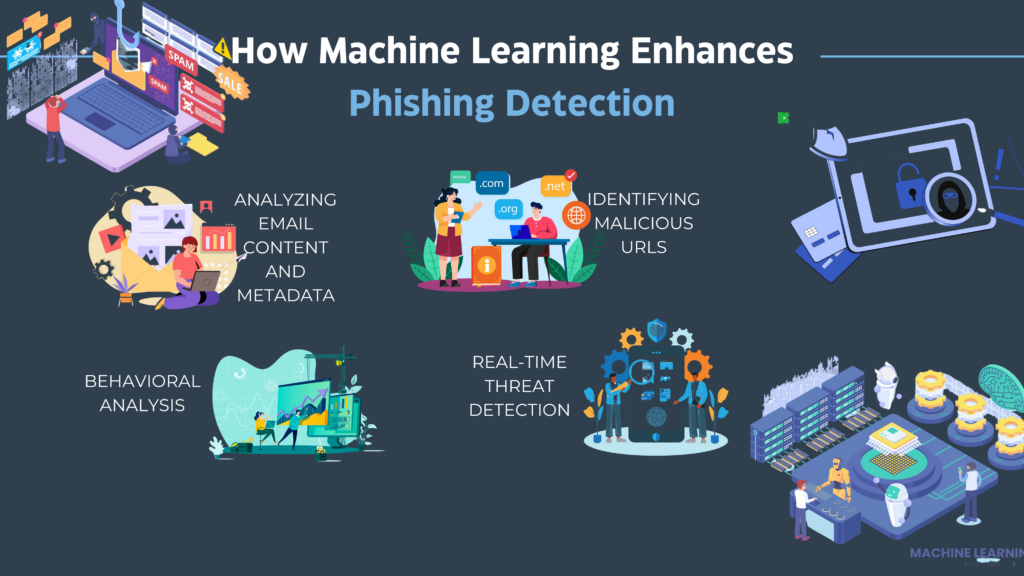
The Role of Machine Learning in Preventing Phishing Attacks
Phishing attacks are among the most prevalent and damaging types of cyber threats today. As cybercriminals become more sophisticated, traditional methods of detecting and preventing phishing attacks are often insufficient. This is where machine learning comes into play. By leveraging advanced algorithms and data analysis, machine learning significantly enhances the detection and prevention of phishing attacks. In this blog, we will explore the role of machine learning in phishing prevention and how it helps safeguard businesses from cyber threats.
Understanding Phishing Attacks
Phishing attacks involve tricking individuals into providing sensitive information, such as login credentials, credit card numbers, or personal identification information, by masquerading as a trustworthy entity. These attacks can occur through emails, websites, or even social media platforms. The goal is to steal sensitive data or install malicious software on the victim’s device.
How Machine Learning Enhances Phishing Detection
Machine learning (ML) is a subset of artificial intelligence (AI) that enables systems to learn from data and improve their performance over time without being explicitly programmed. In the context of phishing prevention, ML algorithms analyze vast amounts of data to identify patterns and anomalies that may indicate a phishing attempt. Here’s how machine learning enhances phishing detection:

1. Analyzing Email Content and Metadata
Machine learning models can analyze the content and metadata of emails to detect phishing attempts. By examining features such as the sender’s address, subject line, body content, and embedded URLs, ML algorithms can identify suspicious patterns that may indicate a phishing email.
2. Identifying Malicious URLs
Phishing attacks often use malicious URLs to direct victims to fake websites. Machine learning algorithms can analyze the structure and behavior of URLs to detect anomalies and flag potential threats. This includes checking for characteristics like URL length, the presence of unusual characters, and the domain’s reputation.
3. Behavioral Analysis
Machine learning can monitor user behavior to detect anomalies that may indicate a phishing attack. For example, if a user suddenly attempts to access sensitive information or perform unusual transactions, the system can flag this behavior as suspicious and take appropriate action.
4. Real-Time Threat Detection
One of the significant advantages of machine learning in phishing prevention is its ability to provide real-time threat detection. ML algorithms continuously learn and adapt to new threats, enabling them to identify and respond to phishing attacks as they occur.
AI Phishing Prevention Tools
Several AI-based tools leverage machine learning to enhance phishing prevention. These tools provide comprehensive protection by analyzing various data points and detecting potential threats before they can cause harm. One such tool is C9Phish by C9Lab, which uses AI to evaluate and enhance your organization’s phishing awareness and training programs. Here’s how AI phishing prevention tools work:
1. Email Filtering and Analysis
AI-based tools analyze incoming emails to detect phishing attempts. They use machine learning models trained on vast datasets of phishing and legitimate emails to accurately identify and filter out malicious messages.
2. URL and Link Analysis
These tools scan URLs and links within emails and web pages to detect malicious content. They use machine learning algorithms to analyze the structure and behavior of URLs, identifying potential threats before they reach the user.
3. User Training and Awareness
AI phishing prevention tools like C9Phish also focus on user training and awareness. They evaluate employees’ responses to simulated phishing attacks and provide tailored training programs to improve their ability to recognize and respond to phishing attempts.
Benefits of Machine Learning in Phishing Prevention
The integration of machine learning in phishing prevention offers several benefits:
1. Increased Accuracy
Machine learning algorithms can analyze vast amounts of data and identify patterns that may be missed by traditional methods. This results in higher accuracy in detecting phishing attempts.
2. Real-Time Threat Detection
ML models continuously learn and adapt to new threats, enabling real-time detection and response to phishing attacks.
3. Reduced False Positives
By accurately distinguishing between legitimate and malicious emails, machine learning reduces the number of false positives, minimizing disruption to business operations.
4. Enhanced User Training
AI-driven tools provide tailored training programs that improve employees’ ability to recognize and respond to phishing attempts, reducing the risk of successful attacks.
FAQs
1. How does machine learning improve phishing detection?
Machine learning improves phishing detection by analyzing vast amounts of data to identify patterns and anomalies that may indicate a phishing attempt. It can analyze email content, URLs, and user behavior to detect threats accurately.
2. What is AI phishing prevention?
AI phishing prevention involves using artificial intelligence and machine learning algorithms to detect and prevent phishing attacks. AI-based tools analyze various data points to identify potential threats and provide real-time protection.
3. How do AI-based tools like C9Phish help in phishing prevention?
AI-based tools like C9Phish help in phishing prevention by analyzing email content, URLs, and user behavior to detect phishing attempts. They also provide tailored training programs to improve employees’ ability to recognize and respond to phishing attacks.
4. Why is real-time threat detection important in phishing prevention?
Real-time threat detection is important because phishing attacks can cause significant damage if not detected promptly. Machine learning enables systems to identify and respond to phishing attacks as they occur, minimizing potential harm.
5. How does user training enhance phishing prevention?
User training enhances phishing prevention by improving employees’ ability to recognize and respond to phishing attempts. AI-driven tools provide tailored training programs based on simulated phishing attacks, reducing the risk of successful attacks.
Conclusion
Machine learning plays a crucial role in preventing phishing attacks by enhancing the accuracy and efficiency of threat detection. By leveraging advanced algorithms and real-time analysis, machine learning significantly reduces the risk of phishing attacks and protects businesses from cyber threats. Incorporating AI-based tools like C9Phish can further enhance your organization’s cybersecurity posture, ensuring comprehensive protection against phishing and other cyber threats.






2 Comments
Some really marvelous work on behalf of the owner of this website , utterly great content material.
Thank you so much for your kind words! 😊 We truly appreciate the positive feedback. It’s always our goal to provide valuable and engaging content, and it’s wonderful to hear that you enjoyed it. If you have any suggestions or topics you’d love to see more of, feel free to share—We’d love to continue creating content that resonates with you!